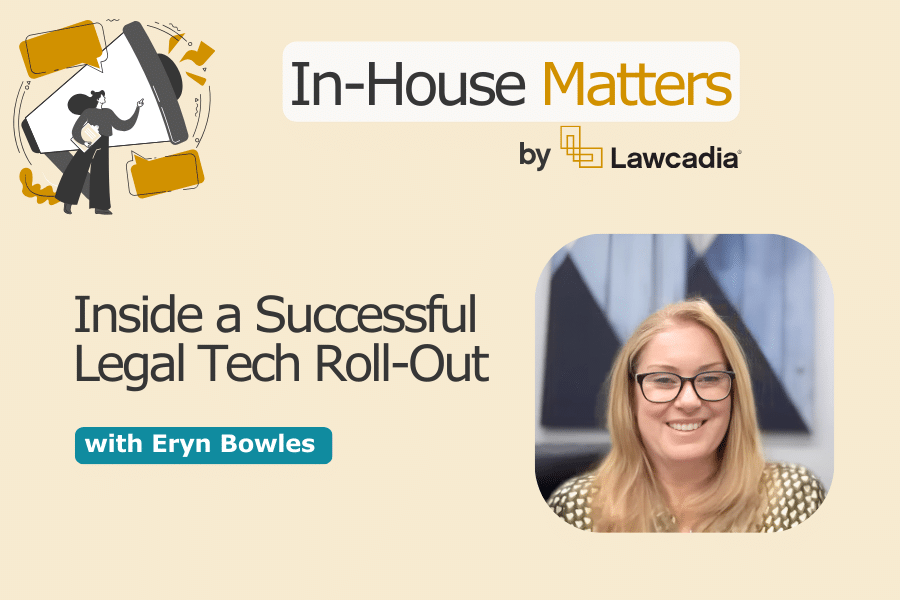Implementing legal technology is rarely just about the software. As Lawcadia COO Eryn Bowles shared in our recent In-House Matters webinar, success hinges on people, processes, and a pragmatic approach to change.
With over 50 legal tech implementations under her belt across corporate and government sectors, Eryn has seen what works, what derails projects, and how to turn even the most sceptical stakeholders into champions.
Start with People, Not Technology
When asked what defines a successful legal tech roll-out, Eryn’s answer was straightforward: “At the end, everybody is happy with the product.”
That doesn’t mean sticking rigidly to the original plan. The reality is that when teams see technology in action, their needs evolve. Success comes from maintaining flexibility while keeping projects on track.
“Sometimes it doesn’t look like what you envisioned at the start. But if you’re hitting your milestones, delivering value, and the team is engaged, that’s success.”
Understanding team dynamics is critical. Every legal department has its “rocks” — the dependable team members who get things done — and, occasionally, a “problem child” resistant to change. Eryn recommends identifying both early and engaging them appropriately. In her experience, bringing sceptics onside can turn them into the loudest advocates.
Preparation Is Everything
Whether a team arrives with fully mapped workflows or only a spreadsheet of current matters, the first step is understanding why they do things the way they do.
The single most valuable preparation before implementation? Define the reports you want to produce.
“If we know what you need to show the C-Suite, we can design workflows that deliver those outcomes from day one.”
This focus ensures the platform meets leadership’s priorities, while other process improvements can follow.
Avoiding the Common Pitfalls
One of the most frequent roadblocks is misalignment between legal and IT.
“Legal and IT often operate in completely different spheres,” Eryn explains. “We get our tech people talking to theirs early to avoid delays later.”
That includes coordinating integrations, setting up single sign-on, and resolving technical requirements well before go-live. Removing these barriers allows legal teams to focus on their work, not troubleshooting technology.
Go-Live Is the Beginning, Not the End
While launching the platform is a major milestone, the work doesn’t stop there. Lawcadia’s implementation team stays closely engaged for at least six months post go-live, running check-ins, adoption reviews, and “pop-in” support sessions.
These informal, open Teams calls allow users to ask questions without the formality of a scheduled meeting — particularly useful for those hesitant to speak up in group training.
“We still see ourselves in project mode for months after launch. The goal is to make sure adoption is strong and the platform is delivering on its promise.”
Driving Adoption Across Legal and the Business
For legal teams, training is targeted and timed close to go-live, supported by follow-up sessions. The aim is not to overwhelm users but to give them the confidence to work in the system from day one.
Business users, on the other hand, need minimal training thanks to intuitive intake forms and built-in support. A key benefit for them is transparency — they can track requests, see who is handling them, and avoid back-and-forth email chains.
“The business loves it. They get clarity, speed, and can see exactly where their request is. It removes friction.”
Communication Is the Glue
If there’s one theme that runs through Eryn’s approach, it’s communication — early, frequent, and transparent. Weekly project updates, clear documentation, and open channels for questions keep everyone aligned.
Eryn is unapologetic about over-communicating: “The worst anyone can say is, ‘I don’t need any more emails.’ But no one can say they didn’t know what was happening.”
Embracing Change Without Over-Engineering
Perfect is a moving target, especially in the early stages. Instead of delaying for complete certainty, Eryn encourages teams to launch with core workflows, knowing the system can evolve.
Tweaks often happen in three waves:
- User Acceptance Testing (UAT): Adjustments during testing with the core project team
- Early Adoption Phase: Feedback from wider team training sessions
- Post Go-Live Reviews: Insights after three months of real-world use
This iterative approach recognises that organisations change — whether through restructuring, legislative updates, or shifting priorities — and the platform should adapt with them.
Turning Resistance into Advocacy
When faced with resistant team members, Eryn’s advice is to take the time to listen. Resistance is often rooted in not feeling heard or understood.
“Separate them out, talk through their concerns, and show how the system will work for them. Once they see the benefits, they often become your strongest supporters.”
This approach not only removes roadblocks but can also strengthen overall buy-in.
Deliver Outcomes, Not Just Projects
Eryn’s closing advice for anyone embarking on their first legal tech implementation is to choose technology partners who are focused on outcomes, not just delivering to a contract.
“You need to feel confident that your partner will get you where you need to be — even if that means going beyond the original scope. It’s not about ticking boxes, it’s about making the technology work for your people.”
Key Lessons from the Webinar
- Start with people and outcomes — technology is the tool, not the goal
- Define your reporting needs early to ensure leadership buy-in
- Engage IT from the start to avoid integration delays
- Communicate relentlessly with all stakeholders
- Expect change and build flexibility into the process
- Support adoption with ongoing check-ins and open support channels
- Turn sceptics into advocates by listening and adapting to their needs
Implementing legal technology can transform how in-house teams operate — but only if the roll-out is managed with the right balance of planning, flexibility, and human understanding. As Eryn’s experience shows, success is about more than just going live; it’s about building confidence, embedding new ways of working, and ensuring the platform continues to deliver long after launch.
Interested in learning more? Access our webinars on-demand.

